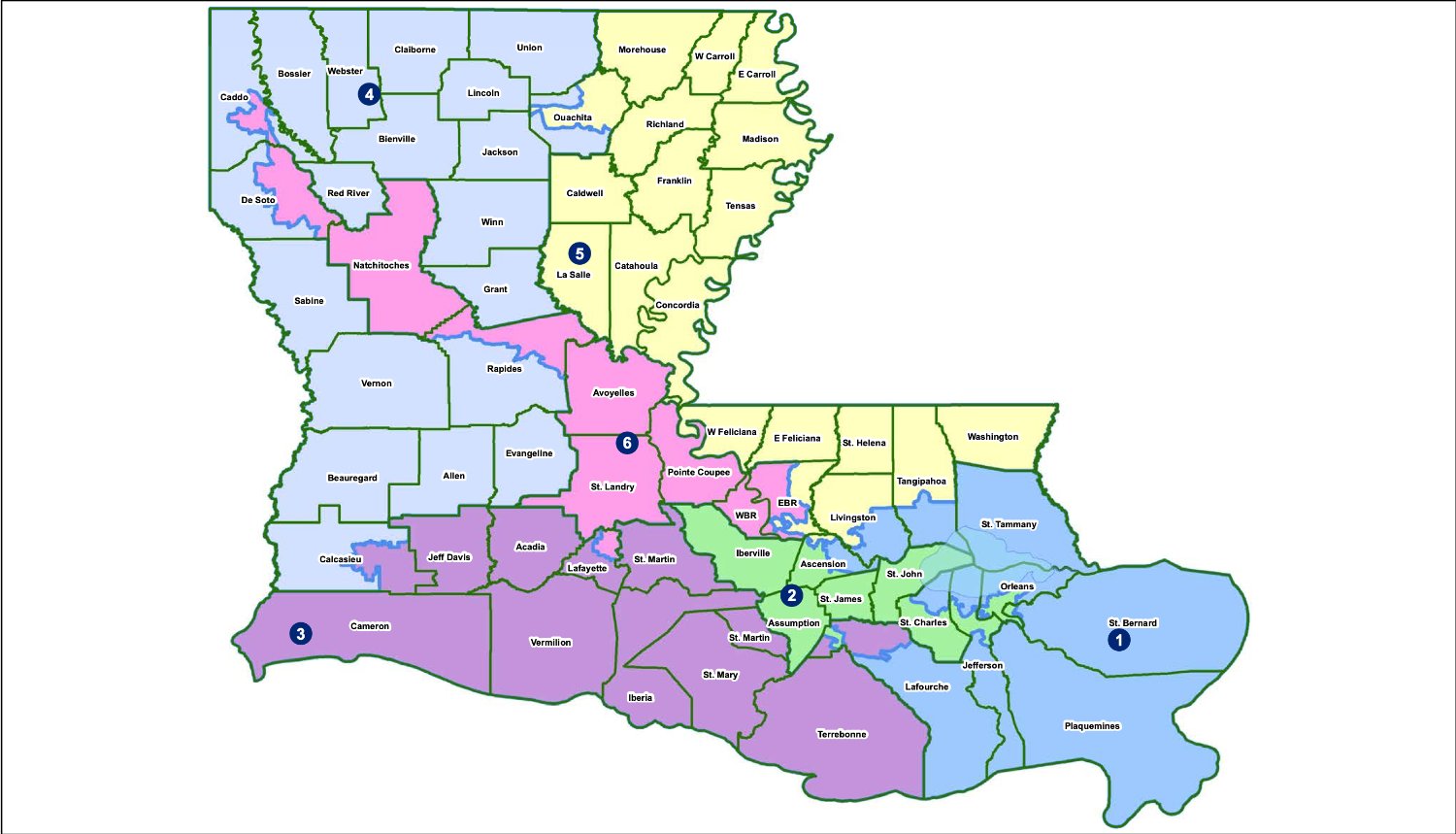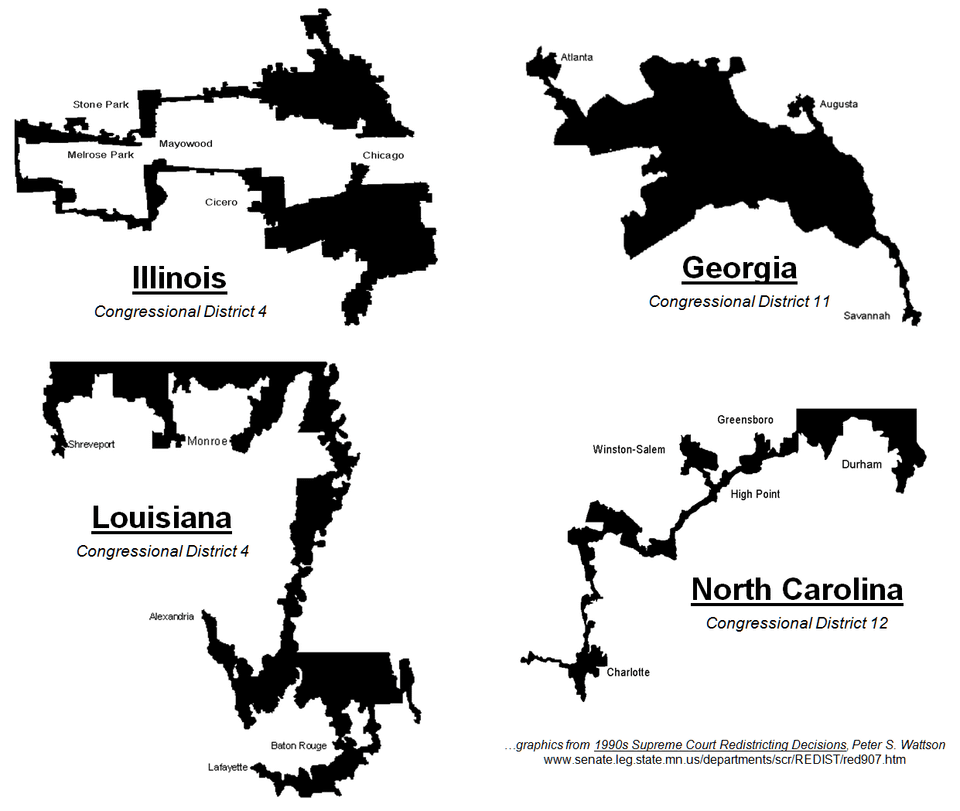I hope this inspires other gerrymandered states
Here I am, sitting in Louisiana where my newly gerrymandered district (4) simultaneously covers a third of the state, surrounds an entire other district, and cuts a relatively blue city clean in half (Lake charles at the bottom).
All so the state can comply with the court order to add another black district while keeping the republican stranglehold.

Wow. This is unbelievable 🤦♂️
Modern Republicans are a cancer to the founding father’s intent of democracy
The “founding fathers” argument is pretty much pro-republican at this point. Unless you’re a property-owning male the founding fathers didn’t want you involved in their “democracy” either.
https://en.wikipedia.org/wiki/Voting_rights_in_the_United_States#Background
They always were. Their name has changed, but they’ve always been here.
How are there two St. Martin parishes within a proverbial block of each other?
Edit: Oh, okay they’re the same parish, geographical locality be damned. https://en.m.wikipedia.org/wiki/St._Martin_Parish,_Louisiana
That looks so simple. Why don’t we all do that?
The short answer is that it would give more populous states a Democrat advantage. Republicans are well aware that they will completely lose power on a federal level if gerrymandering was outlawed.
So blame your local republican for being undemocratic
It’s not happening by choice; it’s happening because voters elected a state Supreme Court which forced it
You’re welcome
Fucking finally.
Election maps seems wild to me. The U.S. make elections really complicated.
I mean… People live in regions. Those regions have representatives. How are those regions defined? Maps. Nothing uniquely American about it as far as I can tell.
Maps generally aren’t strange. District maps are fucked. “Regions” takes on a whole different meaning in the US.

This and absolutely this. We’ve completely ignored the idea of geographical regions having a common interest and bastardized the concept of districts into
-
shoving all of your opponents into one district that only gets one vote
-
slicing up areas that are dominated by friendlies into as many districts as possible
-
in competitive areas, try to shove your opponents into districts that are already lost to you and create narrow bridges through opposing districts linking friendly districts. Essentially, go on a walkabout through the state collecting votes.
There’s even a game you can play where you control redistricting for a hypothetical area. Given the same population, you can draw the maps such that election winners roughly match the proportions of voters, then to give full control to one side, then to give full control to the other side. The idea is to show you how the people who draw the maps can make voting irrelevant.
In democracy voters pick the politicians. In the USA politicians pick the voters
“Corporate Managed Democracy” might more accurately describe the US.
I’m liking this phrase. It’s mine now. I stole it.
Capitalism baby!
Eh. It’s not a very good phrase. I’ll buy it from you for a dollar.
(Think fast. I have already printed 1000 tee-shirts.)
-
Anything to keep power out of the hands of black people and/or poor people who are “woke”.
So does my country, but we don’t change how the regions are distributed every election to benefit one party. Once the region/district is set we leave it alone.
The redistricting every 10 years is because there is a (Constitutionally-mandated) census, and regions/districts change their population, so you have to adjust the representation they get or people will not be fairly represented. You can’t keep the same borders of a city that has grown 30% or the people will be getting less representation per person.
States used to do some dumb stuff like the Nevada State Senate had a district with less than 600 people and a different district with 120k+ and they counted the same. We got rid of that thanks to a Supreme Court ruling in 1964 (Reynolds v Sims).
The unique thing is that, depending on the layout, votes matter differently. I don’t know of any other democratic country that makes it possible to change election results by changing districts.
Yes, we bastardize the districts, but when the upstream comment said “Election maps seems wild to me” (not any map in particular, just the idea of a map) I brought up my point.
No just the idea of a “map”. Election maps that changes because a party wants the advantage is wild to me.
Technically correct, but there are systems that don’t have to rely on maps per say. For example, https://en.m.wikipedia.org/wiki/Party-list_proportional_representation where representatives are assigned proportionally based on the votes. You don’t have “your own representative”.
Obviously there are downsides to this, but at the same time it requires no districts and manipulation in that regard is not possible.
less lopsided than before but still won’t be representative.
It’s a start.
We’ll see. If Republicans can rid Trump’s coat tails like they did in '16, the first thing they’ll do is reverse out all of Evers’s changes and the second thing they’ll do is throw his ass in jail for being a Communist.
The state supreme court will throw out anything too egregious at this point. The next election for that in Wisconsin is in 2025.
That is, short of throwing justices in jail, as well.
It’s way closer to right. See: https://law.marquette.edu/facultyblog/2024/01/analysis-of-proposed-legislative-redistricting-plans-submitted-to-the-wisconsin-supreme-court/
Vote in 2022 for State Assembly ended up with 35D/64R, with D’s getting 44.6% of the overall vote. The Evers maps that are now adopted would have made it 46D/53R. So D’s would get 46.5% of the seats for 44.6% of the vote. It’s a slight D over performance, but no maps are going to be perfectly representative, and this is way closer to what it should be.
I think that it is more informative to look at statewide elections instead of assembly. Gerrymandering depressed turnout and in some heavily gerrymandered districts Republicans were running unnopossed. Looking at statewide elections instead with the new maps democrats will get 46% of seats with roughly 50% of the vote.
First time in many years I feel like I’m being represented and my vote actually mattered. Janet Protasiewicz and Evers are doing some good work here
Do North Carolina next please.
The path to having this happen in Wisconsin was for a set of left-leaning judges to be elected to a majority on the state Supreme Court, and then rule that gerrymandering violated the state constitution. This forced a redraw of the maps.
Marquette University has an analysis of the maps that were proposed: https://law.marquette.edu/facultyblog/2024/01/analysis-of-proposed-legislative-redistricting-plans-submitted-to-the-wisconsin-supreme-court/
The 2022 predicted outcome for those maps is interesting to see. The actual result in the Wisconsin State Assembly was 39D/64R. The Evers maps that are now adopted would have made it 46D/53R–so not a D majority, but the overall vote was 44.6% for D’s, so that’s about what it should be. There were proposals on the table that would have brought that to 35D/64R.
State Senate is even worse. Currently 10D/22R. These maps would have hypothetically been 16D/17R.
Democrats aren’t going to win every time with these maps. The state still has blue cities surrounded by red rural. It does keep Republicans away from a veto-proof majority (which they have in the Senate but missed in the Assembly). Also, it gives Democrats a chance if they can get their shit in order for a change.
Removed by mod
I suspect all the talk about “better representation” is BS. The real reason was technical - collecting votes from an entire continent was not feasible unless you used some proxies. The electoral collage was established half a century before the telegraph was invented. Today we have computer networks. Direct representation is doable.
Today we have computer networks. Direct representation is doable.
On behalf of the people who would make the software that democracy would depend on, let me direct you to this relevant XKCD which I believe still represents the opinion of most engineers.
That is why you have that reported electronically and physically counted. Results quickly, verified results a little bit later. Compare the two.
The software isn’t the problem. In fact, I think that XKCD is on the wrong path. There are verified coding practices that give high reliability. They tend to be used in aerospace or medical devices where people could die if the code is wrong. The rest of the industry has no good reason to adopt them, though, because they take 10 times as long to do anything.
The real reasons against it are articulated better by Tom Scott, who focuses on the usability aspect. A voting system would have to work for everyone, and writing software to do that while also providing certain security guarantees is difficult.
This is exactly how banks manage money. You still fill out the little withdrawal slip, because you’re legally writing yourself permission to take out the money. If someone ever impersonated you to withdraw money from your account, they would be on camera using your ID or bank card, lying on a form, stealing money through fraud. That’s probably 3 felonies, unless one of them is a misdemeanor.
People do it, but they go to jail for a long time for stealing like $3K. It seems easy, but it’s caught relatively quickly.
So I’m Canadian so a lamen to the situation. I always heard Republicans take Gerrymandering to an extreme but do Dems practice it or is this a moral highground thing?..
Before 2010, a number of Democratic states, including California, implemented independent redistricting commissions and the likes in order to prevent gerrymanders.
In 2010, the Republicans took a number of state legislatures, and were then able to use the every-10-years redistricting to gerrymander their way into permanent power and increase their share of seats in the the federal House of Representatives.
This has meant that further anti-gerrymandering measures in Democratic-leaning states would give the Republicans permanent control over one branch of the Federal government, so Democratic-leaning states adopted a no-unilateral-disarmament policy, where they’re no longer passing measures like that at the state level, but regularly try to pass a federal anti-gerrymandering law, which would eliminate it nationally. To date, none of those attempts has gotten past a Republican filibuster in the Senate.
Minority rule
Oligarchy.
Removed by mod
The major notable instance of Democrat gerrymandering is in Massachusetts. They gerrymandered the state so that rather than Republicans having 0 winnable districts, they have 1.
You don’t need to cheat when your party hasn’t been attacking the citizenry for the last 50+ years.
Historically, both are guilty. Today, Republicans are more guilty than Democrats, and this largely comes down to timing and new algorithms to create maps. I’m not going to claim Democrats are inherently more righteous on this issue, except to say that they’re the victimized group and therefore have more incentive to create fair maps right now.
The US Constitution specifies having a census every 10 years, and then a redistricting happens. In 2010, Republicans rode a wave of hate against Obama with the Tea Party, which swept them into a lot of state level offices. This meant they controlled the state legislatures and governors offices that were in charge of redistricting. At the same time, new mapping software let them create extremely lopsided maps. There are cases of individual houses being carved out into one district or another.
This let them hold onto power in those states for the next 10 years. When the 2020 census came around, they still had power, and thus controlled the next round of redistricting. In Wisconsin, that affected the 2022 elections. However, there was also a series of elections for state supreme court, and the 2022 election put in the last liberal justice needed to swing the decision. The maps were ruled unconstitutional, and now we have something where Republicans getting 45% of the vote in the State Assembly means they lose.
(That, BTW, is based on what happened in 2018 for the Wisconsin State Assembly. Vote was 53% D/45% R, but the seats broke down 36D/63R.)
How about use something else than FPTP?
This has to be fixed in Wisconsin before voting methods could be fixed (and a whole list of other things). We only got this because voters put in a state supreme court justice who specifically ran on the map issue.
Incidentally, those state supreme court elections are a non-partisan primary system, so it’s not FPTP already. In practice, all the candidates are unofficially aligned to one of the two national parties, which is an example of FPTP not being the complete story.
See also: a bunch of southern states with runoff voting, where their state offices have been just as filled with Democrats and Republicans as anywhere else in the US over the last century.
Hey US, here’s an idea. Instead of having elected representatives sign off on electoral districts, you can instead pass a law to create electoral commissions who’s job it is, and define in the law how often redistricting should take place, what methods should be used, etc, etc.
The officials at the electoral Commission are bound by the law you set out (and presumably the extremely harsh punishments for not following the law).
This is where you define electoral boundry changes. Not via bespoke legislation where it gets gerrymandered.
A lot of other countries have figured this out, just sayin’.
Yes, that’s something which would work just fine. The situation we’re in looks like this:
- The Supreme Court has ruled that partisan gerrymandering is constitutional
- Republicans block anti-gerrymandering laws in the federal Senate
- If one party ends gerrymandering in states they control (as Democrats started to do between 2000 and 2010) they’re effectively ceding power to the other party on a permanent basis
Yikes. Yeah, understandable that nothing has changed. That sucks :/







